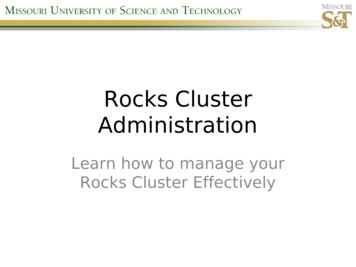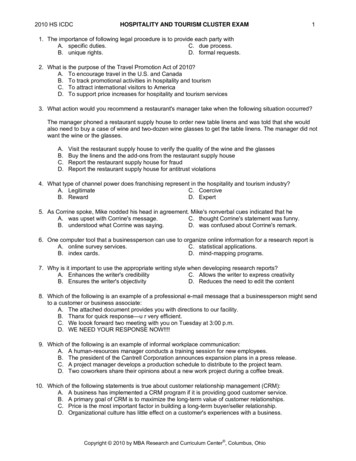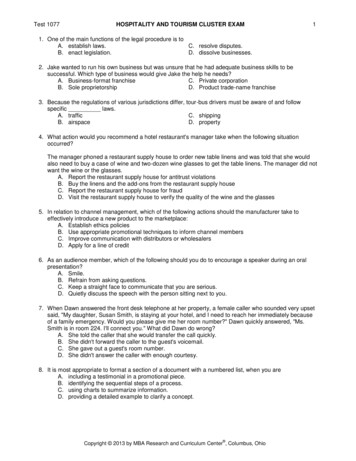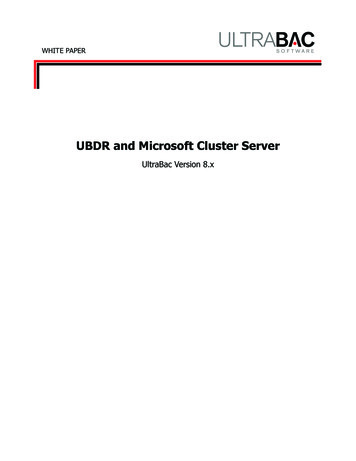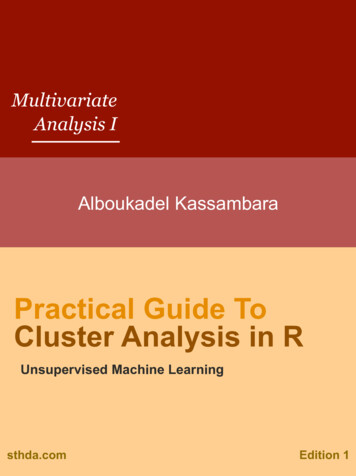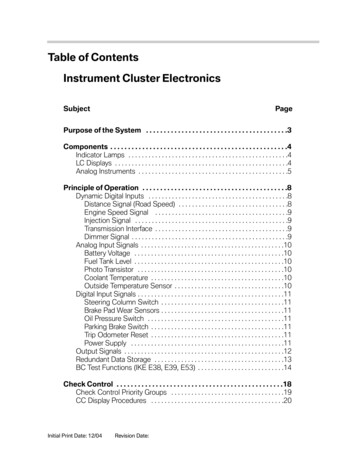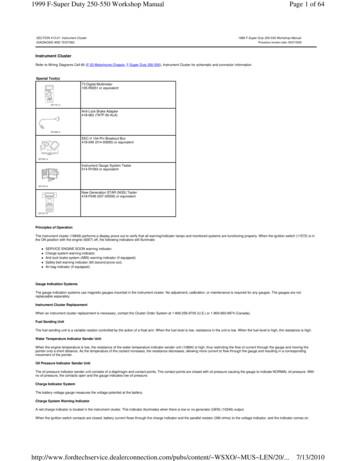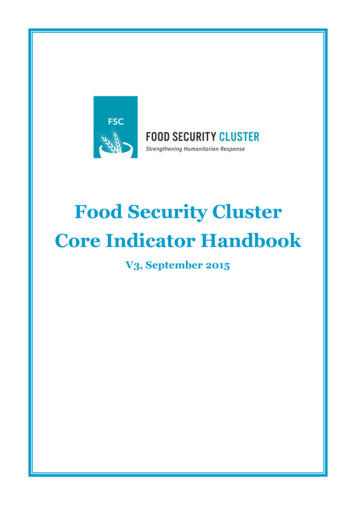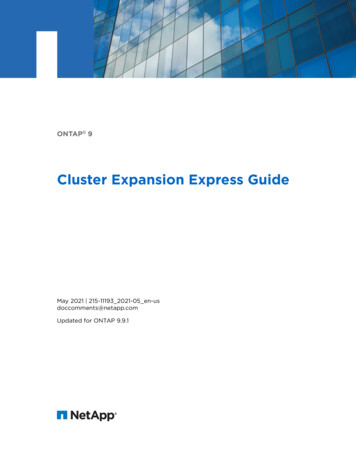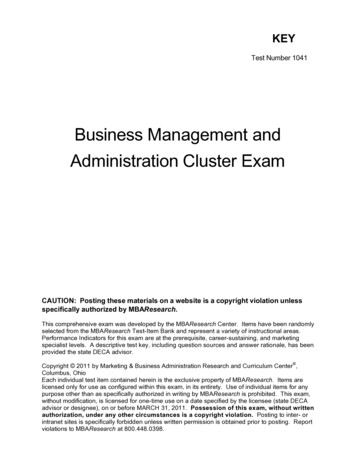
Transcription
KEYTest Number 1041Business Management andAdministration Cluster ExamCAUTION: Posting these materials on a website is a copyright violation unlessspecifically authorized by MBAResearch.This comprehensive exam was developed by the MBAResearch Center. Items have been randomlyselected from the MBAResearch Test-Item Bank and represent a variety of instructional areas.Performance Indicators for this exam are at the prerequisite, career-sustaining, and marketingspecialist levels. A descriptive test key, including question sources and answer rationale, has beenprovided the state DECA advisor.Copyright 2011 by Marketing & Business Administration Research and Curriculum Center ,Columbus, OhioEach individual test item contained herein is the exclusive property of MBAResearch. Items arelicensed only for use as configured within this exam, in its entirety. Use of individual items for anypurpose other than as specifically authorized in writing by MBAResearch is prohibited. This exam,without modification, is licensed for one-time use on a date specified by the licensee (state DECAadvisor or designee), on or before MARCH 31, 2011. Possession of this exam, without writtenauthorization, under any other circumstances is a copyright violation. Posting to inter- orintranet sites is specifically forbidden unless written permission is obtained prior to posting. Reportviolations to MBAResearch at 800.448.0398.
Test 1041BUSINESS MANAGEMENT AND ADMINISTRATION CLUSTER EXAM—KEY101. BConsideration. In a contract, consideration is what one party gives or receives in exchange for somethingelse. In order for a contract to be legally binding, something of value must be exchanged. For example,one party might sell a product to another party and receive monetary payment. Both the product and themonetary payment have value. What one party gives or receives in exchange for something else is notan example of agreement, compensation, or acceptance.SOURCE: BL:002SOURCE: Blackburn, J., & Klayman, E. (2005). The legal environment of business (7th ed.) [p. 180].Boston: Pearson Custom Publishing.2. CAgent. Jenna is the agent because she is the person conducting activities and acting in the best interestsfor the principal, which is The Jones Company. An employer is a business that hires workers(employees) to perform business activities. In the example, Jenna is an agent, but not enoughinformation is provided to determine if she is a Jones Company employee or independent contractor. Acontroller is a person who oversees the accounting aspects of a business.SOURCE: BL:072SOURCE: Blackburn, J., & Klayman, E. (2005). The legal environment of business (7th ed.)[pp. 326-327]. Boston: Pearson Custom Publishing.3. DPractice active listening. This means asking questions and restating what the speaker has said in orderto prevent any misunderstanding. A good listener concentrates on the message being delivered, ratherthan on what s/he is going to say next or on the speaker's personality. Also, by jotting down only keypoints, the listener can concentrate on what is being said.SOURCE: CO:119SOURCE: Farese, L.S., Kimbrell, G., & Woloszyk, C.A. (2009). Marketing essentials (pp. 179-182).Woodland Hills, CA: Glencoe/McGraw-Hill.4. BThe exchange of ideas and information. Understanding must also exist before good communication ispossible. Signals, gestures, and printed materials may all be involved in communication.SOURCE: CO:147SOURCE: Farese, L.S., Kimbrell, G., & Woloszyk, C.A. (2009). Marketing essentials (pp. 178-179). NewYork: Glencoe/McGraw-Hill.5. CAsk questions to clarify other participants' comments. Asking clarifying questions assists the entire groupin learning about the topic. No one in the group knows everything about the topic. Talking togetherthrough tough subjects and sharing diverse viewpoints is the purpose of working as a group. Similarly,she should attempt to assist the group that she has been chosen for instead of asking to be removed.This is not the right time to take a leadership role, which should be assumed by the person who knowsthe most—or has the most experience—about the subject.SOURCE: CO:053SOURCE: QS LAP 29—Put in Your Two Cents6. CDemographics. Demographics are a group's physical and social characteristics, such as interests, ages,political views, incomes, and backgrounds. A profile is similar, but applies at the individual level.Nationality is one kind of demographic. Statistics are often used to report demographics, but are not thedemographics themselves.SOURCE: CO:025SOURCE: QS LAP 9—Well Said!
Test 1041BUSINESS MANAGEMENT AND ADMINISTRATION CLUSTER EXAM—KEY117. ADevelop an outline. It is necessary to organize information in order to present it in a logical manner in abusiness report. An effective way to organize information is to develop an outline. The outline serves asthe plan for the report, and helps the writer arrange the information in the order that will make themessage clear to readers. A writer determines the purpose of the report before gathering and interpretingthe data. Then, it is appropriate to develop an outline. It is important to remain objective while writing thebusiness report.SOURCE: CO:086SOURCE: Leskiar, R.V., & Flatley, M.E. (2005). Basic business communication: Skills for empoweringthe Internet generation (10th ed.) [pp. 280-282]. Boston: McGraw-Hill/Irwin.8. DDeveloping a rough draft. An important step in preparing a simple written report is developing a roughdraft. After the research is complete, the next step is to put the information into a logical format thatcovers the major points of the report. A rough draft may be revised many times, but it is the beginning ofthe actual writing process. Visual aids generally are used to support oral presentations. Scheduling ameeting is not part of writing a report. Interviewing may occur as part of the research process, but it is nota common step in writing simple reports.SOURCE: CO:094SOURCE: Lesikar, R.V., Pettit, J.D., Jr., & Flatley, M.E. (2005). Lesikar's basic business communication(10th ed.) [pp. 100-101]. Boston: Irwin/McGraw-Hill.9. CReceptive. An analytical report is a document that explains and evaluates an issue, opportunity, orproblem. Often, the analytical report includes recommendations for a business to take a certain course ofaction. If the writer anticipates that most members of the audience are receptive and will agree with therecommendations, then using a direct approach to structure the report is optimal. The direct approachinvolves writing the report so it focuses the attention on the conclusions and recommendations. If thewriter anticipates a skeptical, argumentative, or indecisive audience, the indirect approach may be thebest way to structure the report. The indirect approach involves preparing a logical argument thatsupports the recommendations and focuses on the rationale behind the recommendations. Intellect refersto a person's level of understanding about a topic or concept, which varies per person and is notnecessarily related to the structure of the report.SOURCE: CO:185SOURCE: Bovée, C.L., & Thill, J.V. (2008). Business communication today (9th ed.) [pp. 410-411].Upper Saddle River, NJ: Pearson Prentice Hall.10. CBackground. The purpose of a research report is to summarize information gathered from aninvestigation. Companies often review the research report and use it to make business decisions.Research reports contain several elements. The introduction states the problem, purpose, andsignificance of the investigation. The background section of the research report provides historicalinformation and statistical data that have already been gathered, which relates to the problem or purposeof the study. Because the statement focuses on a study that York University has already published, thestatement should be included in the background section of the report. The methodology section focuseson the procedures used to gather the information for the study. The conclusion discusses the researchfindings and may include recommendations.SOURCE: CO:186SOURCE: Walonick, D. (2005). Elements of a research proposal and report. Retrieved July 21, 2010,from oposal.htm
Test 1041BUSINESS MANAGEMENT AND ADMINISTRATION CLUSTER EXAM—KEY1211. CExplain that you can't discuss it. In most companies, salary information is confidential and should not bediscussed. Disclosing confidential information could cause an employee to be reprimanded or fired.Employees who work with such information should not answer questions about it or offer to provide it toothers. It would be overreacting to report those who ask unless the questions are repeated and createproblems.SOURCE: CO:014SOURCE: Kimbrell, G., & Vineyard, B.S. (2006). Succeeding in the world of work (pp. 185-186). NewYork: Glencoe/McGraw-Hill.12. DBe the leader. If a business is large, each department often has regular staff meetings so the managercan communicate important information to employees and keep them informed about current issues.When participating in these staff meetings, the department manager is the leader—the one who runs themeeting and keeps the employees focused on the agenda. As the leader, it may be necessary for themanager to encourage employees to participate or prevent arguments. The manager usually appoints anemployee to record the minutes. Managers oversee and encourage the discussion rather than dominateit. Managers should follow the agenda they set for the staff meetings rather than expand it during themeeting.SOURCE: CO:063SOURCE: Lussier, R.N. (2003). Management fundamentals: Concepts, applications, skill development(2nd ed.) [pp. 327-330]. Mason, OH: South-Western.13. DListen respectfully. The best way for businesses to communicate with customers is to listen respectfully.Customers have a lot of useful information to give businesses if they will listen. Renting billboards,sending direct mail, and providing information about the business are all forms of communication, butnone is as valuable as listening.SOURCE: CR:003SOURCE: CR LAP 1—Accentuate the Positive (Nature of Customer Relations)14. BFair treatment of customers. Clear policies give employees guidelines to follow and help to reducemisunderstandings that create bad feelings. Fair treatment of customers is not an expense-reductionmeasure. Satisfying customers' wants is not possible since wants are constantly changing. The businessmay run more smoothly if customers are treated fairly, but that is not the main purpose of the policy.SOURCE: CR:007SOURCE: Rue, L.W., & Byars, L.L. (2006). Business management: Real-world applications andconnections (pp. 241-242). Woodland Hills, CA: Glencoe/McGraw Hill.15. AFoster goodwill. When their complaints are handled immediately, customers often forget the specifics ofthe complaint, but they will remember how quickly the business responded. A prompt response usuallygives customers a good feeling about the business. There is no law requiring a quick response tocomplaints. Responding quickly will not prevent future complaints. Making a quick response may be partof employee training but is not one of its purposes.SOURCE: CR:010SOURCE: Odgers, P. (2004). The world of customer service (p. 51). Mason, OH: South-Western.16. ASpecialty. Specialty goods are consumer goods with special or unique characteristics consumers arewilling to exert efforts to obtain. Examples of specialty goods include diamond rings, antiques, and oilpaintings. Convenience goods are goods that are purchased quickly and without much thought or effort.Shopping goods are products purchased by customers after comparing goods and stores in order to getthe best quality, price, and/or service. Industrial goods are used to make other products or consumed inthe manufacturing process.SOURCE: EC:002SOURCE: EC LAP 10—Getting the Goods on Goods and Services (Economic Goods and Services)
Test 1041BUSINESS MANAGEMENT AND ADMINISTRATION CLUSTER EXAM—KEY1317. DForm. Form utility occurs when the shape or form of a product is altered in order to make it more useful tothe consumer. Marketing indirectly affects form utility through marketing research and planning.Marketing has a direct effect on other forms of utility. It affects place utility by making products availablewhere consumers want them. It affects time utility by making products available when consumers want tobuy them. And, it affects possession utility by creating circumstances under which ownership of theproduct can be transferred from seller to buyer.SOURCE: EC:004SOURCE: EC LAP 13—Use It (Economic Utility)18. BMarketing. Marketing is the process of creating, communicating, and delivering value to customers andmanaging customer relationships in ways that benefit the organization and its stakeholders. Withoutmarketing, businesses would have no way to sell their products, and consumers would have no way toobtain needed products. Operations management is the process of planning, controlling, and monitoringthe day-to-day activities required for continued business functioning. Strategic management is theprocess of planning, controlling, and organizing an organization or department. Financial analysis is theprocess of planning, maintaining, monitoring, controlling, and reporting the use of financial resources.SOURCE: EC:071SOURCE: EC LAP 19—Strictly Business (Business Activities)19. AIt may have different consequences than breaching ethics. Breaching business ethics and breaking thelaw may have different consequences. For example, breaching business ethics alone could result in lossof customers, while breaking the law could result in fines or jail time. Both breaching business ethics andbreaking the law are unacceptable practices in most industries, are not necessary for business success,and will not make a company more popular. In fact, doing so will hurt a company's public image.SOURCE: EC:106SOURCE: EC LAP 21—On the Up and Up (Business Ethics)20. DCompetition. Competition is the rivalry among two or more businesses to attract scarce customer dollars.Fair competition is essential if the private enterprise system is to work as it was intended. Monopolies areallowed to exist in a private enterprise economy only if they are regulated. Exclusive agreements andprice fixing are illegal.SOURCE: EC:012SOURCE: EC LAP 8—Ready, Set, Compete! (Competition)21. CEnsuring a business's profitability. Businesses in a free enterprise economy have the risk of loss or gain.The government is not involved. Government is involved in protecting business property by providing themilitary and by providing trademarks, patents, and copyrights to artists and inventors. Governmentenforces business contracts and settles business disputes through the courts.SOURCE: EC:008SOURCE: EC LAP 16—Regulate and Protect (Government and Business)22. CRemain stable. Inflation is a rapid rise in prices that may occur when demand exceeds supply or whenproductivity declines and costs of labor go up. Generally, low inflation rates range between one percentand four percent, which indicates a strong economy and stable prices. Although some products' pricesfluctuate on a daily basis (e.g., gasoline), not all prices do. High inflation causes a decrease in the valueof a nation's currency.SOURCE: EC:083SOURCE: Clark, B., Sobel, J., & Basteri, C.G. (2006). Marketing dynamics (pp. 120-122). Tinley Park,IL: Goodheart-Willcox.
Test 1041BUSINESS MANAGEMENT AND ADMINISTRATION CLUSTER EXAM—KEY1423. AOne year. A nation's income is derived from all of the goods and services that it produces. By measuringhow much a country produces, we can determine its national income and its general economic health.Our nation's income, or gross domestic product (GDP), is measured once each year by the Departmentof Commerce.SOURCE: EC:017SOURCE: EC LAP 1—Measure Up? (Gross Domestic Product)24. CThe U.S. culture and the geographic region of the country affect the formality of business meetings.Cultural differences are common in different regions of a single country. For example, businesspeopletend to wear conservative suits and ties on the east coast of the United States, while businesspeople onthe west coast tend to be more casual. On the west coast, meeting participants may wear businesscasual clothing (e.g., golf shirts), which reflects their more relaxed lifestyle. U.S. businesspeople tend toembrace the "time is money" mindset, so they do not always value time more than money. Foreignbusinesspeople cannot assume that U.S. businesspeople make decisions in a particular way—slowly orquickly. The circumstances dictate the way in which decisions are made. For example, the level of groupinput needed for decision making depends on the business's type, size, structure, and policies. ManyU.S. business transactions take place in social situations—on the golf course, over a meal, or at asporting event.SOURCE: EC:130SOURCE: Cyborlink.com. (n.d.).United States of America: Introduction. Retrieved May 13, 2010, fromhttp://www.cyborlink.com/besite/us.htm25. BHello, Herr Schmidt. Using titles to greet friends or business associates is common practice in Germanculture. Herr is the German word for Mister (Mr.), so it would be appropriate to greet Rudolph Schmidt byhis title and last name, which is Herr Schmidt. Carolyn might want to use a common greeting used byGermans, such as, "Guten tag, Herr Schmidt," which means, "Good day, Mr. Schmidt." Sir is a title usedby Great Britain to address individuals who have been knighted by the British monarch (i.e., QueenElizabeth). Greeting the client using the first and last name would not be appropriate. Senor is theSpanish word for mister.SOURCE: EC:131SOURCE: Cyborlink.com. (n.d.). Germany: Behavior. Retrieved May 14, 2010, fromhttp://www.cyborlink.com/besite/germany.htm26. AAppearance. To make a positive impression on foreign business partners, it is important to "dress forsuccess." Cultures have different views regarding appropriate dress and personal appearance. Althoughpantsuits are appropriate attire for businesswomen in other countries, skirts are more common andacceptable in Japanese culture. Translation is a language consideration. Cleanliness is a personalhygiene issue. Qualifications are an individual's level of expertise in a subject or job.SOURCE: EC:133SOURCE: Cyborlink.com. (n.d.). Japan: Appearance. Retrieved May 14, 2010, fromhttp://www.cyborlink.com/besite/japan.htm27. DHandshake. Greetings are an important gesture to consider when meeting with foreign businesspeople.The tone of a meeting can be negatively impacted by using an inappropriate greeting. Therefore,businesspeople should conduct research and determine the appropriate way to greet their foreignbusiness partners. The handshake is the most common greeting in Middle-Eastern countries. It isimportant to extend your right hand for the handshake because Middle-Eastern religious beliefs considerthe left hand unclean. A bow is appropriate in Japanese culture. A head nod may be considered rude inmany cultures. A kiss may be considered inappropriate or too forward and personal.SOURCE: EC:134SOURCE: Kwintessential. (n.d.). Doing business in the Middle East. Retrieved May 14, 2010, g-business-middleeast.html
Test 1041BUSINESS MANAGEMENT AND ADMINISTRATION CLUSTER EXAM—KEY1528. CWinking. A gesture is a movement of the body or limbs that expresses or emphasizes an idea, sentiment,or attitude. Because the meanings of gestures differ by country, it is important for businesspeople tounderstand and monitor their body language in foreign business situations. Certain gestures (e.g.,winking) may be friendly in some cultures but offensive or disrespectful in other cultures. Listening is animportant communication skill and would not be offensive to foreign businesspeople. Yelling andmumbling are forms of verbal communication, which may be offensive or annoying in various
Test 1041 BUSINESS MANAGEMENT AND ADMINISTRATION CLUSTER EXAM—KEY 13 17. D Form. Form utility occurs when the shape or form of a product is altered in order to make it more useful to the consumer. Marketing indirectly affects form utility through marketing research and planning. Marketin
